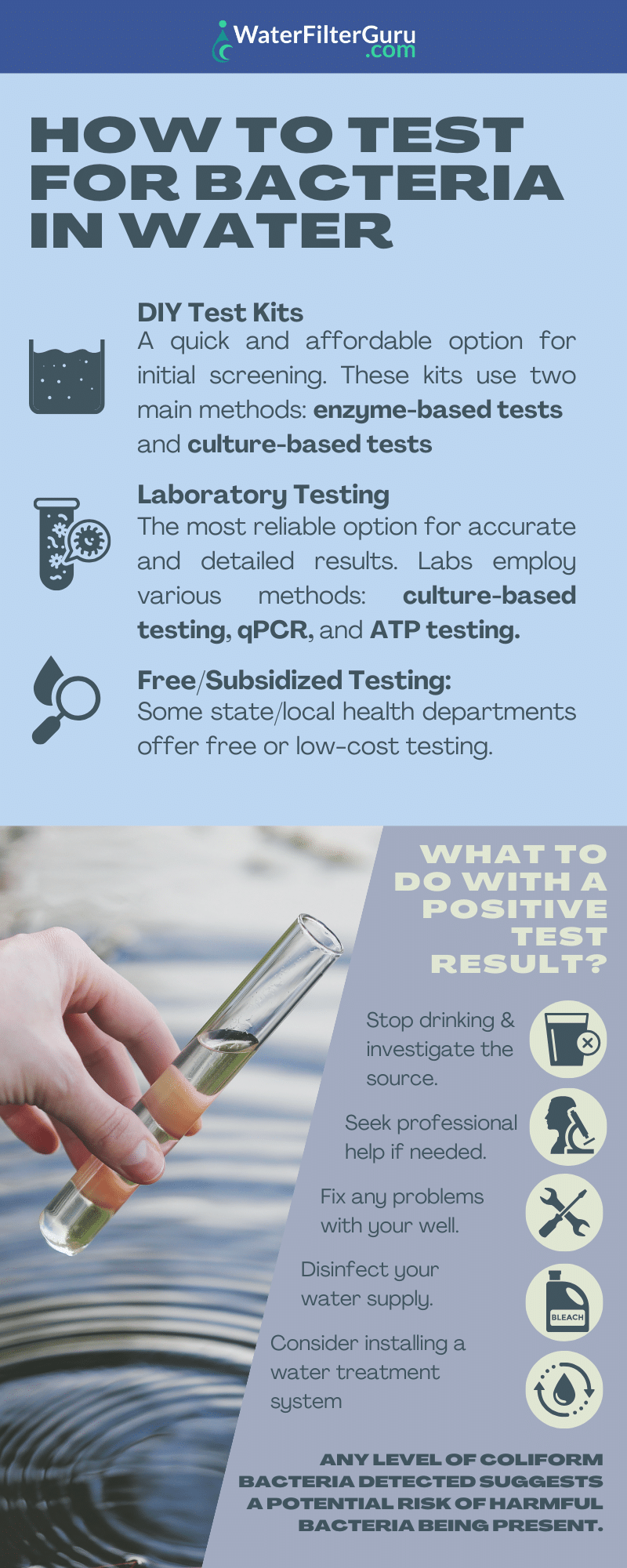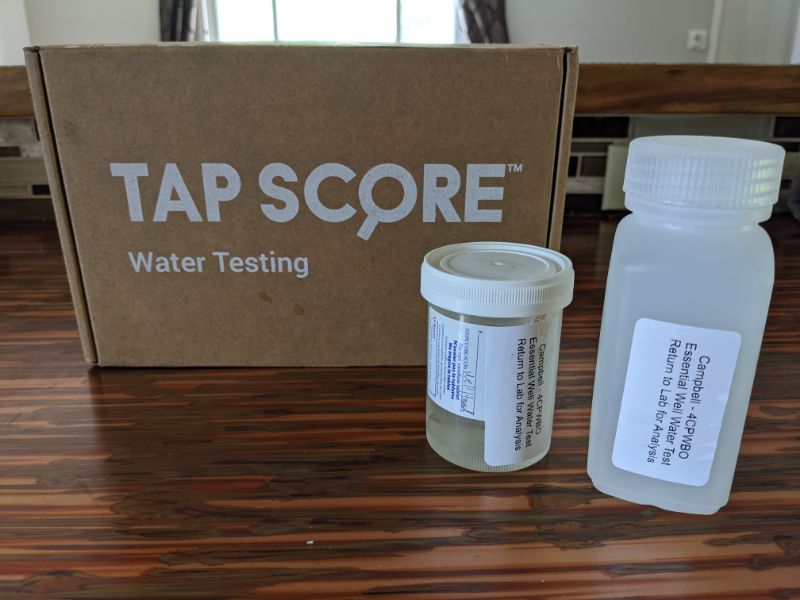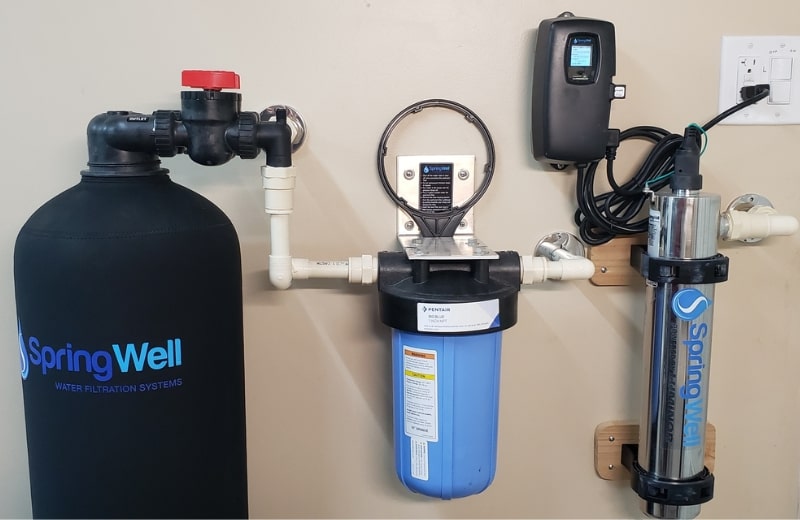If you get your water from a private well, there’s a risk that it may contain bacteria. A USGS study of 146 household supply wells found total coliform bacteria in nearly 70 percent of the wells sampled, indicating the potential presence of more dangerous bacteria strains.
While some bacteria are safe in water, others – like E. Coli (a type of fecal coliform) can cause health effects including nausea, vomiting, abdominal cramps, and in worst cases, death.
We’ve asked our water treatment experts to recommend their top recommended methods of testing for bacteria in water, and we’ve shared these methods in this guide.

Table of Contents
🧪 Use a DIY Water Test
The cheapest and fastest way to test your water for bacteria is to use a DIY test kit.
At-home bacteria water tests use several methods to detect the presence of bacteria in water. Commonly, these kits include culture-based tests, enzyme-based tests, or other chemical indicators.
Here’s an overview of how each of the two most common at-home testing processes work:
- Enzyme-based tests: These tests are the most commonly used for DIY bacteria testing and typically target specific enzymes produced by bacteria, which, if present, cause the water sample to change color. They’re relatively accurate, but generally not as sensitive as more sophisticated lab testing methods.
- Culture-based tests: These tests involve growing bacteria in a culture medium. They’re a good option to provide some indication of bacterial presence, but they might not detect all types of bacteria.
We recommend DIY bacteria tests as the best solution for initial screening – they’re ideal if you just want to know whether or not your water contains bacteria.
Different DIY tests for bacterial contamination require different testing processes. We’ve outlined an example testing process below.
- Buy your preferred DIY water testing kit specifically designed for bacterial detection.
- Unbox the kit and read the instructions before you get started.
- Wash your hands or put on a pair of protective gloves (if included).
- Collect a cold water sample as directed by the kit. If your kit comes with a vial, use this to collect the sample.
- Perform the test. This could include adding a reagent to the sample, sealing the lid on the test container, and shaking it thoroughly.
- Incubate the water sample according to the test instructions. Most tests require 24-48 hours of incubation.
- Interpret your results. You might notice color changes, the presence or absence of bacteria growth, or other indicators, depending on the type of test you’ve conducted. If your test comes with a color chart, consult this to determine the level of contamination.
Good to Know: The effectiveness of DIY bacteria tests may vary, and they’re generally not as accurate or comprehensive as professional lab testing methods.

🚰 Submit a Water Sample For Certified Laboratory Testing
The best option for reliable bacteria testing is to use a certified water testing laboratory.
Certified lab testing uses comprehensive bacteria detection methods to provide clear, detailed results. We recommend using a professional lab test if you want the most accurate insight into whether your water contains bacteria, and how much.
When you purchase a bacteria test kit from a laboratory, you’ll receive a package in the post with sampling vials and instructions for collecting a water sample. You’ll then mail your water sample to SimpleLab and receive your test results via email.
Here’s the typical process of taking a water sample for a bacteria laboratory test:
- Choose and order your preferred test, then wait for the sample kit to be shipped to you.
- Unbox the sample kit and familiarize yourself with the instructions provided by the lab.
- Put on a pair of protective gloves (if provided in the kit).
- Collect the sample in the included container.
- Securely cap the container, fill out any paperwork or forms included with the kit, and return the samples to the box.
- Send the sample to the lab as soon as possible. Make sure to follow any transportation and storage instructions provided by the laboratory.
- Wait to receive your results (typically by email).
Laboratory testing takes longer than DIY testing – the typical turnaround time is around 5-7 days, depending on the testing method used – but we recommend this option to folks who have a real reason to be concerned about disease-causing bacteria in their water and need to identify possible contamination with the most accurate test method.
Our Expert Recommendation: We’ve used Tap Score by SimpleLab on dozens of occasions to test for bacteria as part of our water filter testing process. There are several SimpleLab test packages for bacteria to choose from, including the Universal Bacteria Genetic Identification Test, which tests for “all bacteria at the DNA level”. If you prefer to test for multiple contaminants at once, the Essential Well Water Test is a good option – it tests for total coliforms and E. Coli.

Popular Methods of Laboratory Testing for Bacteria
There are a few different methods that a laboratory might use to test for bacterial contamination, including:
Culture-Based Testing
This method involves incubating a water sample in a nutrient-rich medium, which encourages the growth of bacteria. After the incubation period, scientists can then identify and count the colonies. Culture methods are widely used and are generally effective for identifying and quantifying a range of bacteria. However, depending on the specific testing conditions, not all bacteria may grow.
Quantitative Polymerase Chain Reaction (qPCR)
qPCR is a molecular biology technique that can provide information about the presence and quantity of specific bacterial species. This testing method is highly sensitive and specific, so scientists can use it to detect low concentrations of bacteria. It’s also a relatively quick process.
ATP (Adenosine Triphosphate) Testing
ATP testing measures the amount of ATP – a molecule present in all living cells, including bacteria – and is commonly used to detect microbial growth in wastewater treatment. The test assesses the overall microbial load in a sample based on ATP concentration, so it can’t be used to identify specific bacteria in a water supply.
📲 Contact Your State or Local Health Department
If you want the accuracy of a lab test for bacterial contamination but have a tight budget, see if your state or local health department offers free or subsidized laboratory water quality testing for total and fecal coliform bacteria.
Your local environmental or health department should list the licensed laboratories near you, which should be helpful if you’re specifically looking for local labs.
You can find local laboratories by calling the Safe Drinking Water Hotline at 800-426-4791 or visiting this directory produced by the EPA.
📝 Interpreting Your Results
Once your results are in, you can decide whether or not you need to take action.
The Environmental Protection Agency (EPA) has established a Maximum Contaminant Level (MCL) of 0 PPM for total coliform bacteria, including the fecal coliform group and E. Coli. So, if any coliform contamination is detected in your water, there’s a risk that it could contain disease-causing organisms.
If you’ve received a positive result, stop drinking your water immediately and switch to a bottled water supply.
We recommend following a four-step process to address a positive test result that indicates bacteria in your water system:
- Determine the source. Try to determine the source of the contamination, and whether it’s an isolated incident or a continual problem. For instance, has local flooding or an earthquake contaminated your well? Or does your well need repairing to prevent contamination in the future?
- Seek professional help (if necessary). You may decide to contact a licensed water treatment professional to properly evaluate your situation, identify issues, and recommend solutions.
- Fix any issues you discover. If you’ve determined a problem – such as well structural issues, for example – that needs to be fixed to ensure water is safe to drink, work on fixing this as soon as possible.
- Shock chlorinate your water. You should also use a disinfectant like chlorine to kill the bacteria in your water supply. Our guide on how to shock chlorinate your well is a good resource for this process.
- Install a water treatment system. For peace of mind and to protect your drinking water supply from future contamination, install a water treatment solution that can address bacteria, such as a chemical feed system, a UV purifier (an increasingly popular choice due to its chemical-free operation), or an RO water system.
Looking to learn more about the best treatment options for coliforms? Take a look at our guide on the best water filters for coliforms here.

📑 Final Word
We wrote this guide in the hopes of providing a comprehensive resource to anyone looking to test for bacteria present in their drinking water supply.
Hopefully we covered everything you wanted to know, but if you have any further questions or are looking for advice for your specific situation, leave us a comment below – we’ll be happy to help.
Remember, certain bacteria can potentially cause severe illness, so you should treat the presence of bacteria as a serious problem. If you’re on a private well, follow the CDC’s advice and test your well water annually for total coliform bacteria.
